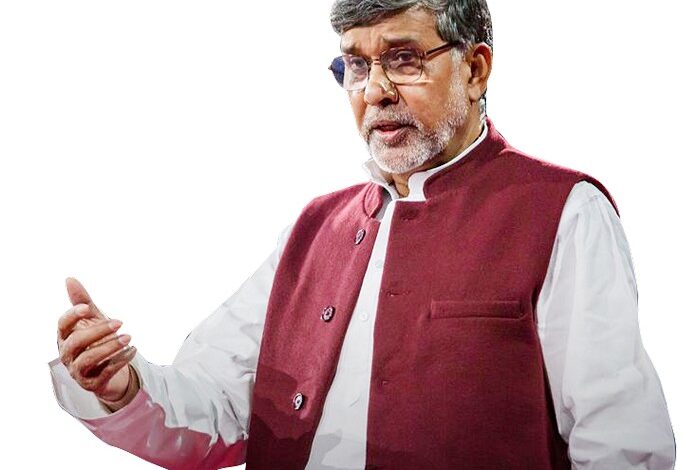Kailash Satyarthi – Nobel Peace Laureate

Igniting change for children in the world
Indian Nobel Peace Laureate Kailash Satyarthi is an inspiration to billions of Indians and people worldwide for his ground-breaking work in protecting children rights all over the world.
During the last 37 years, the electrical engineer turned child rights activist has been instrumental in highlighting violations taking place against children, the most vulnerable elements in society, and in helping rescue and rehabilitate them from all forms of exploitation.
Speaking to The Times Kuwait in an exclusive interview, Mr. Satyarthi said that it took 35 years for him to make the world recognise about children’s exploitation, but within 35 minutes of him winning the Nobel Peace Prize in 2014, the rights of children became a global issue.
“For the first time in more than 100 years it was recognised that there cannot be peace in the world without caring for our children, and the Nobel Prize set the ball rolling making it a global issue,” said the activist.
“As the most vulnerable of all classes of people, children exploitation has been a centuries old issue and needed to be addressed,” he said, while pointing out that new legislation covering comprehensive children’s rights have now been set in motion and is slowly taking centre stage on global platforms.
“Since children have no voting rights, political interest in child issues are minimal,” he noted, adding that new legislation would make it mandatory for governments to protect and care for children, something which was long required in the world.
Mr. Satyarthi was in Kuwait to speak before a distinguished gathering at the Jaber Al Ahmed Cultural Centre (JACC), in an event organised by TakMinds, a new platform launched by Takreem. The platform headed by Richard Karam highlights how changemakers and emerging talents are addressing current societal challenges.
As the chief guest-speaker, Kailash Satyarthi spoke eloquently about how children’s issues were impacting the global peace process, as well as the need to act fast and comprehensively.

Since starting his movement Bachpan Bachao Andolan (Save Childhood Movement) in 1981, Mr. Satyarthi has helped rescue over 87,000 children from child labor, trafficking and slavery. It is in recognition of these efforts he was awarded, along with young Pakistani activist Malala Yousafzai, the prestigious Nobel Peace Prize in 2014, “for their struggle against the suppression of children and young people and for the right of all children to education.”
In addition to child labor and slavery, Mr. Satyarthi is an active campaigner for children’s rights on several fronts, including all forms of violence against children, such as sexual abuse, rape, health, malnutrition and others.
The Kailash Satyarthi Children’s Foundation that was set up after he received the Nobel Peace Prize in 2014 has been at the forefront of fighting for the protection of children everywhere.
Soft spoken and mild-mannered Mr. Satyarthi recalled that in 1998 he launched a global march against child labor where tens of thousands of people from several concerned organizations in more than 103 countries participated. This event helped put the spotlight on children’s rights once again.
A tireless campaigner for child rights, Mr. Satyarthi shared his plans to launch his largest, most ambitious campaign yet, for which he hoped to recruit 100 million young people across the world, who would unite to rescue 100 million less fortunate children. He repeatedly emphasized that no problem in the world is isolated. “People can’t live in islands of prosperity anymore,” he said, adding that this was the largest attempt to channelize youth energy and power, so they become the changemakers for 100 million victims of violence.
Another initiative of his foundation is to build a strong platform of Nobel laureates and moral leaders from all walks of life who had a proven track record of helping children in their own way. This initiative was launched in India in 2016 at the Rashtrapathi Bhavan, the official residence of the Indian President.
Yet another resourceful act of his is in setting up an independent global think-tank policy institute for children that works with governments. This soon to be established institute would be set up in Andhra Pradesh, India, in the near future.
Mr. Satyarthi pointed out that all these are new initiatives are unique and have never been undertaken in the past. “Some of the policy successes and accomplishments we had in the past, resulted in the ILO convention 182, which helped bring the issues of child abuse to the forefront,” he said.
“I am now working with the United Nations on a new convention that will further expand the protection of children; this will be a legally binding international pact with very specific clauses against online child pornography, sexual abuse and child trafficking,” he disclosed.
The Kailash Satyarthi Children’s Foundation that was set up after he received the Nobel Peace Prize in 2014 has been at the forefront of fighting for the protection of children everywhere.
Mr. Satyarthi, who met His Holiness the Pope in Rome recently to seek his support for the UN convention, said that he was very pleased with the meeting and the positivity shown by His Holiness towards the issue. He added that the Pope has appointed an officer from the Vatican to coordinate with the Kailash Satyarthi Children’s Foundation to combat the menace of child abuses in all forms.
Elaborating on the issue of children’s rights, Mr. Satyarthi said that for a long time this was not acknowledged as a human rights violation, and even though a lot of good work was being carried out to help children, it was still not enough. He also disputed the notion that child labor is directly linked to poverty, pointing out that there are almost 210 million jobless adults who can easily replace the 150 million children workers; so every single child labor is working at the cost of an adult.
“There are studies in many countries including India that indicates most child laborers belong to parents who are not able to find work for even 100 days. Children cannot form unions, they are vulnerable and get exploited so there is a parallel between adult unemployment and child labor,” he pointed out.
Elaborating on this, he added child labor was the biggest impediment in child education; if children are not able to get quality education then they would be poor for the rest of their lives, he said while emphasising that if one had to get rid of poverty then education was very important.
Globally $22 billion was required annually to ensure primary education, and $39 billion was required to ensure education up to secondary grade. “We have to prioritize education to see the social change and gender justice,” he said, pointing out that governments are the main stake holders followed by the corporate sector.
His earnest efforts on behalf of children have reaped dividends, but still there is so much left to do, he said. The problem is interconnected and educating the masses on the issue is also of vital importance, “I am trying to attack the problem from all angles and the enemy is child labor,” he stressed.
A documentary on Mr. Satyarthi’s work in support of children will be released on November 27. Titled, ‘Price of Free’, the film has been made by celebrity filmmaker and academy award-winning director Davis Guggenheim, whose previous two documentaries, ‘Inconvenient Truth’ and ‘Waiting for Superman’, won accolades.
The documentary ‘Price of Free’ is the culmination of three years of work by the producers who have tracked the Nobel Peace Laureate in his daily schedules. The film is being dubbed in six languages and will be the first major movie launch on YouTube.
The ‘Price of Free’ Mr. Satyarthi said symbolises that freedom does not come free. The early screening of the movie has been very well received and he hopes the movie will further help his cause of combatting child exploitation.
Speaking about child labor in his home country India, Mr. Satyarthi feels there is lot left to be done. Although some progress has been made in terms of changes in the child labor law, which completely bans child labor up to the age of 14, and in hazardous work up to the age of 18, there remains more to be done.
He said India recently ratified two ILO conventions on the worst forms of child labor and the country is now looking at a holistic law for child labor that will include punishment, implementation and rehabilitation.
Still the issue of funding scarcity exists, he said, as India has a youth population of nearly 40 percent and yet the budgetary allocation is nowhere near the required amounts. He expressed hopeful optimism that eventually children’s issue would be brought to the mainstream.
By Reaven D’Souza
Managing Editor













